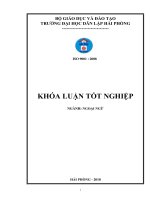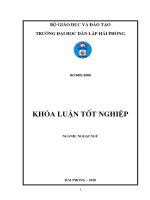A study on English semantic synomyms
Bạn đang xem bản rút gọn của tài liệu. Xem và tải ngay bản đầy đủ của tài liệu tại đây (435.76 KB, 57 trang )
Bộ giáo dục và đào tạo
Tr-ờng Đại học dân lập hải phòng
--------------------------------
Iso 9001:2008
Khoá luận tốt nghiệp
Ngành: Ngoại ngữ
Hải phòng 2009
1
Hai phong private university
Foreign language department
*********************
Iso 9001: 2008
Graduation paper
A study on PREPOSITION OF TIME IN ENGLISH
By: NguyÔn ThÞ HuyÒn Trang
Class: NA903
Supervior: NguyÔn ThÞ Thu HuyÒn, BA
HAI PHONG – 2009
2
Bộ giáo dục và đào tạo
Tr-ờng đại học dân lập hải phòng
----------------ooo----------------
Nhiệm vụ đề tài tốt nghiệp
Sinh viên: .....................................................................Mã số:................................
Lớp: .......................................Ngành:......................................................................
Tên đề tài: ..............................................................................................................
.................................................................................................................................
3
Nhiệm vụ đề tài
1. Nội dung và các yêu cầu cần giải quyết trong nhiệm vụ đề tài tốt nghiệp
(Về lý luận, thực tiễn, các số liệu cần tính toán và các bản vẽ)
2. Các số liệu cần thiết để thiết kế, tính toán
3. Địa điểm thực tập tốt nghiệp
4
ACKNOWLEDGEMENT
This graduation paper is the result of my continuous working time. I would
like to take this opportunity to express my particular thanks to my supervisor,
Ms Nguyen Thi Thu Huyen, BA of Hai Phong Private University, for her
enormously helpful and effective instructions, constant and tireless help and
support throughout the study.
I would like to show my deepest gratitude to all lectures in English
Department of Hai Phong Private University.
I also would like to give my thanks to all pre-researchers and authors for
their beneficial materials used in this graduation paper.
Finally, I am indebted to all the members of my family who always
encourage and support me for the completion of my graduation paper.
That is all important and whole-hearted assistance helping me to full fill
this graduation paper.
Nguyen Thi Huyen Trang
5
ABBREVIATIONS
1. N
=
Noun
2. Adj =
Adjective
3. Adv =
Adverb
4. V
Verb
=
5. Eg =
Example
6. i.e
In explanation
=
6. Pre =
Preposition
7. AmE =
American English
8. BrE =
Britain English
6
TABLE OF CONTENT
ACKNOWLEDGEMENT
ABBREVIATIONS
PART ONE: INTRODUCTION.......................................................................... 1
1. Rationale of the study....................................................................................... 1
2. Aims of the study..............................................................................................1
3. Method of the study.......................................................................................... 1
4. Scope of the study.............................................................................................2
5. Design of the study........................................................................................... 2
PART TWO: DEVELOPMENT.......................................................................... 3
Chapter 1: Theoretical background...................................................................... 3
I.1 Overview on English preposition.................................................................... 3
I.1.1. Definition.................................................................................................... 3
I.1.2.Position of English preposition.................................................................... 4
I.1.3. Classification of preposition........................................................................5
I.1.3.1 According to compositional types............................................................ 5
I.1.3.2 According to the semantic relation............................................................7
I.1.4. Semantic properties of preposition............................................................13
I.1.5. Functions of preposition............................................................................ 14
I.1.5.1. Prepositions functioning as adjectives................................................... 14
I.1.5.2. Prepositions functioning as adverbs....................................................... 14
I.1.5.3. Prepositions functioning as nominals.....................................................14
I.1.6. Prepositions in parallel form..................................................................... 14
I.2. Prepositional Phrase.....................................................................................15
I.2.1.Definition................................................................................................... 15
I.2.2. Structure of prepositional phrase...............................................................16
I.2.3. Complementation and modification in Prepositional phrase structure..... 18
Chapter II: An investigation into preposition of time and their Dimension....... 21
II.1. Preposition of time...................................................................................... 21
7
II.1.1. Definition................................................................................................. 21
II.1.2. Classification............................................................................................21
II.1.3. Absence of preposition of time................................................................ 25
II.2. An analysis of the dimension of preposition of time................................. 28
II.2.1. Dimensional preposition of time..............................................................28
II.2.2. An analysis of dimension of preposition of time..................................... 29
II.3. The influence of preposition of time prepositional complement................ 32
Chapter III: Some difficulties encountered by English Learners and some
suggested solution when using preposition of time............................................ 33
III.1.Confusion of Preposition of time in relation to conjunction and adverb....33
III.1.1. The borderline between preposition of time and conjunction................ 33
III.1.2. The borderline between preposition of time and adverb........................ 33
III.2. The confusion of using some pairs of preposition of time.........................34
III.3. Confusion of the variety of lexical meanings of preposition.....................36
III.4. Missing of preposition of time.................................................................. 37
PART THREE: CONCLUSION........................................................................ 39
REFERENCE......................................................................................................40
APPENDIX A
APPENDIX B
8
PART ONE: INTRODUCTION
1. Rationale of the study
Learning foreign language is getting more and more important in our
society nowadays. When we know a foreign language, we will understand and
As we all know, prepositions occupy a smaller number than other parts of
speech like noun or verb but they play an important role in making a correct
sentence. How to understand and use them correctly is not easy. In four-year
studying English I myself as well as other students sometimes get confused at
using prepositions.
In the process of looking for books and researching documents related to
preposition, I found that there are many kinds of preposition and I am really
interested in prepositions of time in English. English prepositions of time
constitute a very important element of sentence formation. They help to
establish a grammatical as well as semantic concord between different parts of a
sentence which refer to time, periods of time, and duration of events and
activities. Therefore, I decided to choose the time preposition as topic for my
study in the B.A graduation paper.
2. Aims of the study
Give an overview on English prepositions and their subclasses. In
particular, prepositions of time.
Help the learners at intermediate level understand the difference between
preposition of time „when‟ and time „duration‟ in English.
Identify problems of English foreign language learners when using
prepositions of time.
Give suggested solutions to the problems of English language learners
when using prepositions of time
3. Scope of the study
Preposition of time is a comparatively wide part in English preposition. I am
fully aware that my graduation paper cannot cover all aspects of prepositions in
9
English, so I focus on preposition of time with some typical aspects relating to
them such as: Overview on English preposition as well as preposition of time,
the analysis of the dimension of preposition of time and problems raised when
using preposition of time and suggested solutions for them.
4. Method of the study
In order to gain the mentioned aims of the study, I try my best to collect
related documents in reference books, from web pages and dictionaries. This
theme is studied on the basic of analyzing, contrasting, research on linguistics
and my knowledge, experiences during four-year -studying in Hai Phong Private
University. Furthermore, discussions with my classmates and consultation with
the supervisor are really helpful for my paper.
5. Design of the study
My graduation paper is divided into three parts:
The first part is introduction of the paper consisting of the rationale, the aims,
the scope, the method, the design of the study.
The second part is the development with three chapters. Chapter one is
theoretical background of preposition including overview on English preposition
and prepositional phrase. Chapter two is an investigation into preposition of time
in English including time „when‟ and time „duration‟ composing by introduction
of preposition of time, an an analysis of the dimension-types of preposition of
time. Chapter three deals with the problems of English foreign language learners
when using preposition of time and some solutions to those problems. Part three
is conclusion which summaries what have been discussed in the previous parts
and put an end to the study.
10
PART TWO: DEVELOPMENT
Chapter I: Theoretical Background
I.1. Overview on English preposition
I.1.1. Definition of preposition in English
A preposition is traditionally defined in the following ways:
“A preposition is a word that indicates a relation between the noun or pronoun
it governs and another word which may be a verb, an adjective or another noun
or pronoun” ( Curme, 1935: 87)
(1) (a)
(b)
She voted against us
She was depends on us
(c)
Her opinion of us improved
In three examples above, the words „against, on, of’ are
treated as
prepositions. The preposition against is said to relate us to the verb voted, the
preposition on shows the relation between adjective dependent and the pronoun
us, and preposition of in the third sentence indicates the relation between the
noun opinion and the pronoun us
The concept of “indicating a relationship” however, is very vague and such a
definition is clearly in need of considerable refinement (whether construed at the
general or language-particular level) to distinguish prepositions from, for
example, verbs and „coordinating conjunctions‟, which can also relate one NP to
another, as loves and and do in Ed Loves Kim, and Kim arrived.
In spite of significance of prepositions, standard grammars often assign
them a rather vague definition, such as “a word that shows the relation of a noun
and pronoun to some other word in a sentence”. (Warriner and Griffith,
1965:16)
The key word in this definition is „relation‟. Relations signaled prepositions as
just noted, are both grammatical ( e.g, modifier of noun or verb) and semantic
11
(e.g, recipient, benefactive). This double role of prepositions will often provide
important clues to the structure sentences.
I.1.2. Position of English prepositions
A preposition is followed by a "noun". It is never followed by a verb.
By "noun" we include:
noun (dog, money, love)
proper noun (name) (Bangkok, Mary)
pronoun (you, him, us)
noun group (my first job)
gerund (swimming)
A preposition cannot be followed by a verb. If we want to follow a preposition
by a verb, we must use the "-ing" form which is really a gerund or verb in noun
form.
eg:
She saved money by giving up cigarettes.
However, prepositions may also come after nouns
e.g:
in questions like ‘What are they looking for?
Different prepositions can have very similar uses
e.g:
in the morning, on Monday morning.
Many nouns, verbs and adjectives are normally used with particular
prepositions
e.g.
the reason for, arrive at, angry with, on a bus.
In English prepositions can come at the end of clauses, especially in an
informal style
e.g
What are you thinking about?
You are just the person I was looking for.
She’s not very to talk to.
I hate being shouted at.
12
Here are some examples:
Subject + verb preposition
"noun"
The food is
on
the table.
She lives
in
Japan.
Tara is looking
for
you.
The letter is
under
your blue book.
Pascal is used
to
English people.
She isn't used
to
working.
I ate
before
coming.
I.1.3 Classification of preposition in English
There are two ways to classify preposition:
I.1.3.1 Classification according to compositional types:
Simple preposition:
Most of the common English prepositions, such as: at, in and for, are simple,
ie consist of one word. Other prepositions consisting of more than one word
are called complex or multi-word preposition. The following is a comprehensive
list of simple prepositions
(F = Formal)
Aboard
About
Above
Across
After
Against
Along
Alongside
Amid(st)
Among(st)
Apropos(of)
Around
With
As
By
On (upon)
At
Despite
Opposite
Atop
Down
Out
Before
During
Outside
Behind
For
Out with
Below
From
Over
Beneath
In
Past
Beside
Inside
Per
Besides
Minus
Plus
Between
Notwithstanding Re
Beyond
Of
Round
But
Off
Since
within
without
Table 1: Simple (Single-word) prepositions
13
Round
Since
Than
Through
Throughout
To
Toward
Under
Underneath
Until (till)
Up
via
* In addition to this table, there are a few words which behave in many ways
like prepositions although they have affinities with verbs or adjectives: Except,
excepting, bar, barring, concerning (F), considering, following, including,
granted, pending (F), less, like, near, save, unlike, worth.
(2)(a)
He gave us all bar (= except) three of sketches
(Quirk. R, 1972: 301)
(b)
Concerning all these disadvantages, his performance was quite good
( Huddleston, R,1984:346)
Complex prepositions
Most complex prepositions are placeable, according to their form, into one of
three categories:
Adverb + prep: along with, apart from, aside from, as for, as to, away from,
into, off of, on to, (or onto), out of, together with, up to, etc.
Verb/Adjective/conjunction/etc + Prep: except for, owing to, due to, but for,
because of, etc.
Prep 1 + noun + Prep 2: by mean of, in comparison with, on account of, with
regard to, in consequence of, etc.
This category may be further subdivided according to which prepositions
function as Prep1 and Prep 2
In + Noun of: in case of, in charge of, in view of, in need of, in spite of, in
front of, in lieu of, in favor of, in place of, in face of, in aid of, in quest of, in
respect of, in search of, in consequence of, etc.
In + Noun + with: in connection with, in contact with, in common with, in
line with, etc.
By + Noun + of: by means of, by way of, by virtue of, by dint of, etc.
On + Noun + of: on account of, on behalf of, on top of, on pain of, etc.
Other types: at variance with, in exchange for, in return for, in addition to, in
relation to, etc.
Here the table list of complex prepositions:
14
Along with
Apart from
Aside from
As for
As to
Away from
According to
By mean of
By way of
By dint of
By reason of
By virtue of
In case of
In front of
In relation to
In charge of
In view of
In need of
In spite of
In front of
In favor of
In place of
In common with
In quest of
In respect of
In search of
In consequence of
In connection with
In contact with
In aid of
In line with
In exchange for
In addition to
In lieu of
In to
At variance
Off of
On to
Out of
Owning to
On account of
On behalf of
On top of
On pain of
Except for
But for
Because of
With regard to……
Table 2: Complex ( Multiword) prepositions
I.1.3.2 Classification according to the semantic relations
In the survey of prepositional meanings to which most of this chapter is
devoted, time and place relations will be dealt with first, and will be followed by
a more cursory exemplification of other relationships such as: “goal” “cause”
“purpose”…So varied are prepositional meanings that no more than a
presentation of the most notable semantic similarities and contrasts can be
attempt here.
Prepositions of time
Prepositions of time usually occur as adjuncts or post modifiers, but it can
occasionally be itself the complement of a temporal preposition as in:
(3)(a)
(b)
We camped there for the summer
I haven’t seen him in years
(Quirk, R, 1973: 154)
The subclasses of prepositions of time consist of those indicating point of
time like: at, in, on…; duration time like: since, for, till, until,during…..up
to…; relationship of time like: before,after, between, from….to….
15
Prepositions of place
Prepositions of place are typically either adjuncts (relating an event or state
affairs to a location) or post modifier ( relating some “ object” to a location) they
may also act as obligatory „ predicative‟ adjuncts following the verb BE as the
following example:
(4) (a)
My car is at the cottage
(b)
Tom went to the door.
(Quirk, R, 1973: 146)
Some prominent prepositions of place are: to, at, from, away from, on(to),
on, off, (in)to, in, out of, etc.
Prepositions of place comprise two groups including those indicating
position like: at, in, on….and those indicating direction which often go with the
verbs indicating movement like : to, into…going with the verbs: go, walk,
crush…..
For example:
(5) (a)
Adam went to the station to meet Sheila
(Collin, C, 1997: 140)
(b)
He crashes into the fence
(Collin C, 1997 : 93)
Prepositions of cause or reason
There are prepositions expressing either the material cause or the psycological
cause for a happening:
(6)(a)
(b)
Because of the drought, the price of bread was high that year.
On account of his wide experience, he was made chairman.
(Quirk, R, 1973: 56)
Other prepositions of cause or reason include: for, from, due to, owing to,
etc.
Phrase of cause and reason answer the question “Why”
Prepositions of purpose or intended destination
Let us consider the following examples:
16
(7)(a)
Everyone ran for shelter
He’ll do anything for money
(b)
(Quirk, R, 1973:156)
The use of “for” illustrated above have in common a notion of “purpose”.
The notion of „purpose‟ can be seen from the possibility of paraphrase by a
clause in order to: for money = in order to gain money.
Phrases of purpose or destination answer the questions „Why….?‟,
„What…for?‟, „Where…for?‟, „Who….for?‟
They frequently occur as post-modifiers as well as adverbials:
The scenery for the play, etc.
Preposition of recipient, goal, target
The number of propositions expressing recipient, goal, target is limited, they
include for, to, at. Although they are organized in the same group of meaning, in
certain case it is easy to realize the differences between them.
When preposition “for” is followed by noun-phrases denoting persons or
animals, the meaning is rather one of “intended recipient”
(8)
He made a beautiful doll for his daughter
(Quirk, R, 1973:157)
* The for phrase can often be equated with an indirect object.
In contrast, while the preposition ‘for’ expresses „intended recipient‟, the
preposition ‘to’ expresses „actual recipient‟.
(9)
I gave the book to my friend.
(Quirk, R, 1973: 157)
At, in combinations such as aim at (where the prepositional phrase is
complementary to the verb), expresses intended goal or target:
(10) (a)
(b)
After aiming carefully at the bird, he missed it completely
A vicious mongrel was snapping at his ankles.
(Quirk, R, 1973: 157)
Prepositions of source and origin
The converse of “to” (= ‘goal’) is “from” (= ‘source’):
17
Bill lent the book to me ↔ I borrowed the book from Bill
(11)
(Quirk, R, 1973:157)
„From‟ is also used with reference to „place of origin‟:
(12)
He comes from Australia (= He is Australian)
(Quirk, R, 1973:157)
Other of source, origin consists of “of”:
(13)
I have a little hat made of wool.
(Collin, C, 1997: 104)
This type of prepositional phrase occurs not only as an adjunct, but as a postmodifier: The man from Mars, a friend of mine from London
Prepositions of manner, means and instrument
The prepositions of manner comprise with, in…manner, like, as as in the
following sentences:
(14)(a)
We were received with the utmost courtesy
(b)
The task was done in a workmanlike manner
(c)
The army swept through the city like a pestilence
(Quirk, R, 1973: 158)
* Note that like with intensive verbs, as in: Life is liked a dream, refer not to
manner but to resemblance.
The prepositions of means and instrument include by, with, without.
By can express the meaning „by means of‟:
(15)(a)
(b)
(c)
I usually go to work by bus/train/car.
The thief must have entered and left the house by the back door
By working the pumps, we kept the ship afloat for another 40 hours
(Quirk, R, 1973:158)
With, on the other hand, expresses instrumental meaning as in:
(16) (a)
(b)
He caught the ball with his left hand
Someone had broken the window with a stone
(Quirk, R, 1973:158)
18
For most senses of with, including that of instrument, without expresses
the equivalent negative meaning:
(17)
I drew it without a ruler (= I did not draw it with a ruler)
(Quirk, R, 1973: 158)
Phrases of means and instrument answer the question “How…?‟
(18)
A: How did he do it?
B: By working hard
(Quirk, R, 1973: 158)
Prepositions of accompaniment
There is only one preposition with the meaning of accompaniment which
is preposition “with”. Especially when followed by an animate complement,
with has the meaning „in company with‟ or „together with‟.
(19) (a)
(b)
I’m so glad you’re coming with us
Jock, with several of his friends, was drinking till 2 am.
(Quirk, R, 1973:159)
In the sentence (35), the „With’ phrase serves a function very close to
coordination with „and‟: „Jock and several of his friends were……..‟
Prepositional phrase of accompaniment functions as post-modifier thus in:
(20)
Curry with rice is my favorite dish
(Quirk, R, 1973:160)
Prepositions of support, opposition
There are three prepositions: „for, against, with’ expressing the meaning of
support or opposition. Thus in:
(21)(a)
Are you for or against the plan?
(= Do you support or oppose the plan?)
(b)
Remember that every of us with you
(= on your side)
(Quirk, R, 1972:326)
For conveys the idea of support, with that of solidarity or movement in
sympathy, against conveys the contrary idea of opposition.
19
Prepositions of concession
There is variety of prepositions expressing the concessional meaning, such
prepositions or prepositional phrase as: despite, in spite of, for + all, with + all,
notwithstanding. Convey the same meaning, concession, though there is still a
little difference in meaning between them and they are often separated from the
main clause by a comma.
(22) (a)
I admire him, in spite of his fault
(b)
He lost the fight, for all his boasting
(Quirk, R, 1973:161)
(c)
With all his boasting and ostentatious training, he was
knocked out in the first round by a man lighter than himself.
(d)
Thomas, notwithstanding his tedious rhetoric, is a master of the
sublime in prose style.
(Quirk, R, 1972: 328)
In spite of is a general-purpose preposition of concession; despite is rather
more formal and notwithstanding is formal and rather legalistic in style. The
combinations for all and with all (all being an obligatory pre-determiner with
this meaning) are chiefly colloquial.
Prepositions of subject matter
With the meaning „on the subject of, concerning‟, about and on can
combine with a considerable range of verbs and adjectives including:
Speak out/on
:
teach (someone) about
Argue about/ on
:
read about
Hold forth about/ on
:
hear about
Lecture about/ on
:
quarrel about
Preach about/ on
:
keep quite about
Confer about/ on
:
tell (someone) about
Write about/ on
:
inform (someone) about
On tends to refer to deliberate, formal linguistic communication (speaking
lecturing, writing, etc) and is therefore inappropriate for verbs like chat or
20
quarrel, teach, which do not necessarily involve the subject of the sentence in
using language.
(23)
He spoke on butterflies
(Quirk, R 1973:162)
Would suggest he was making a formal speech, however the sentence:
(24)
He spoke about butterflies
(Quirk, R, 1973:162)
Would probably refer to an informal conversation or causual allusion
* Semantic types of Prepositions
Semantic types
Prepositions
Time
At, in, on, about, during, for , since….
Place
Above, around, at, behind, beneath, ….
Cause and reason
Because of, on account of…..
Purpose or intended destination
For…
Recipient, goal, target
For, to, at…
Source and origin
To, from, of…
Manner, means, instrument
With, in, by,,,, without……
Accompaniment
With
Support, opposition
For, against, with
Concession
Despite, in spite of, for + all, with + all
Subject matter
About, on
Table 3: Semantic types of prepositions
I.1.4. Preposition in parallel form
When two words or phrases are used in parallel and require the same
preposition to be idiomatically correct, the preposition does not have to be used
twice.
(25) (a)
(b)
You can wear that outfit in summer and in winter.
The female was both attracted by and distracted by the male's dance.
However, when the idiomatic use of phrases calls for different prepositions, we
must be careful not to omit one of them.
21
(26)(a)
The children were interested in and disgusted by the movie.
(b)
He was fascinated by and enamored of this beguiling woman.
( />
I.1.5. Function of prepositions
Prepositions perform three formal functions in sentences. They can act as an
adjective modifying a noun, as an adverb modifying a verb, or as a nominal
when used in conjunction with the verb form to be.
I.1.5.1. Prepositions functioning as adjectives
In the following sentences, prepositional phrases perform the function of
modifying the nouns boat, pen, and car:
Look at the boat with the blue sail.
Please hand me the pen next to the telephone.
Park the car beside the fence.
I.1.5.2. Prepositions functioning as adverbs
In these examples, notice how the prepositional phrases perform adverbial
functions by modifying the verbs after, stalled, and won:
The coyote runs after the rabbit.
The car stalled despite the tune-up.
The team won without the starting quarterback.
I.1.5.3. Prepositions functioning as nominals
In English, sometimes words function as nouns but aren't themselves nouns.
These words are called nominals. Prepositions sometimes perform this important
function in sentences when they are used in conjunction with the verb to be.
For example:
The park is next to the hospital.
The student is between an A and a B.
The fight scene is before the second act.
I.1.6. Semantic properties of prepositions
22
In semantic terms, the preposition functions to illustrate a logical, temporal,
or spatial relationship between the object of the prepositional phrase and the
other components of the sentence. Consider the following examples:
(27)
The dog is asleep on his bed.
In this example, the prepositional phrase on his bed indicates a spatial
relationship between the subject dog and the object bed. If the preposition on
was replaced with under or beneath the spatial relationship would be altered.
(28)
The town hasn't been the same since the war.
In this sentence, the prepositional phrase since the war indicates a temporal
relationship between the verb phrase hasn't been the same and the object war.
(29)
The family survived despite the accident.
The prepositional phrase despite the accident in this sentence indicates a logical
relationship between the survival of the family and the accident.
I.2. Prepositional phrase
I.2.1. Definition of prepositional pharse
A prepositional phrase consists of a preposition followed by a prepositional
complement, which is characteristically a noun phrase or a wh-clause or V-ing
clause
(Quirk, R, 1973:142)
(30) (a)
Every single person without a computer background failed.
(b)
That’s a good way of trying to get to know each other.
(c)
It’s just a question of which is more efficient approach.
(Greenbaum, S, 1996:159)
That-clauses and infinitive clauses, although they frequently have a nominal
function in other respects, do not occur as prepositional complements.
Alternative between the presence and absence of preposition are observed in
case like:
(31)(a)
(b)
(c)
He was surprised at her remark
He was surprised at her saying this
He was surprised at what she said
23
(d)
He was surprised that she said
(Quirk, R, 1973:142)
Further examples of verbs and adjectives which can have either prepositional
complements or that-clauses are: decide (on), inform (of), insist (of), afraid (of),
aware (of), sorry (about), sure (of)…
I.2.2. Structure of prepositional phrase
Many grammars make a distinction between „simple preposition‟ consisting of
a single word, and „complex preposition, consisting of from two to four words
including at least one simple preposition as we mentioned in part I.1.3
The structure of prepositional phrase (PP) headed by a complex preposition
will be distinguished from that of a PP containing a smaller PP embed within it.
For example, by dint of hard work will have the structure shown in (32a)
(32)(a)
By dint of hard work
PP
Prep
NP
Prep
N
Prep
AdjP
N
By
dint
of
hard
work
Whereas after years of hard work (where there is no complex preposition) will
have that shown in (32b)
24
(32b)
After years of hard word
PP
Prep
NP
N
PP
Prep
NP
AdjP
After
years
of
hard
N
work
There are, however, considerable difficulties with this analysis.
It is reasonable to regard (32b) as a more basic or elementary syntactic
construction than (32a). After has an Np as complement, following the most
frequent structure for PPs; the NP Years of hard work contains a PP as post-head
dependent, which again is a very frequent structure for NPs; putting these two
standard structures together then yields (32b), which thus represents a virtually
fully productive construction. In (32a), by contrast, there are very severe
restrictions on the permitted combinations of words in the complex prepositions,
such that the latter must be listed in the dictionary as wholes rather than being
the output of general rules. We may think complex prepositions as rising
historically through the „lexicalisation‟ . The fusion into a single lexical item –
of the first words of some productive construction like (32b). (The dint which
survives in by dint of meant “stroke, blow”). Analysis (32a) takes this
lexacalisation to be accompanied by a syntactic regrouping such that the
lexicalized sequence becomes a syntactic constituent.
25









